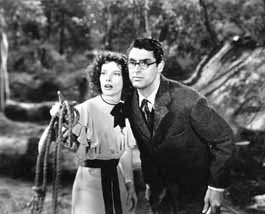home | metro silicon valley index | movies | current reviews | essay

RKO Radio Pictures/Photofest
The lady and the scientist: Cary Grant doesn't have a chance when Katharine Hepburn starts to purr in 'Bringing Up Baby.'
Lioness
The Stanford Theatre explores the pols of Katharine Hepburn's screen persona in two-month festival
By Richard von Busack
MANY WOMEN progress from vivaciousness to madness—their scintillation, by and by, begins to strobe like an ambulance light. What once was lambency becomes the raw-nerved sensitivity of someone whose skin is too thin and too tight. In nine calmly civilized comedies with Spencer Tracy, Katharine Hepburn showed her middle range, a strong, self-possessed and free-thinking woman.
But it is her extremes that are remembered in a two-month retrospective at the Stanford Theatre. In two films, she shows us both the merry patrician exterior and the neurotic tension inside. In Bringing Up Baby—the greatest painkiller this side of a martini—Hepburn is a demigoddess of mischief. Some 25 years later, she plays the mother in A Long Day's Journey Into Night, a junkie simultaneously clinging to and pushing her family away. And she's perfect in both parts.
Hepburn's 100th birthday is May 12. She was the daughter of a progressive doctor; her mother helped Margaret Sanger found Planned Parenthood. After Bryn Mawr, Hepburn went on the New York stage. She was signed by David O. Selznick, who saw her playing an Amazon huntress carrying a fresh-killed deer on her shoulders.
Typically, Selznick dithered over what to do with her once he had her. He had her photographed dressed as Joan of Arc and thought of casting her in a jungle adventure movie. Finally, Hepburn debuted in A Bill of Divorcement (screening May 11–13) as a woman seemingly doomed to inherit madness.
"I had taken a tremendous chance in casting Hepburn," Selznick is quoted in Haver's David O. Selznick's Hollywood. "The world knows that startling Hepburn face now, but when she first appeared on screen in the rushes, there was consternation ... 'Ye gods, that horse face.'"
For much of her first 10 years in movies, Hepburn was an unpopular figure at an unpopular studio, RKO. She was uncooperative with the publicity machine, and the press retaliated. Otis Ferguson, the smart critic who stayed a devoted fan through some patience-trying movies, wrote, "About Katherine Hepburn, it has recently been fashionable to wink, and pull a face, and poor Kitty and tsk, tsk, tsk, Hollywood has ruined her and of course she never was more than a couple of mannerisms and a hank of hair to start with, poor Kate." Ferguson helps himself to this defensive sarcasm in his review of Stage Door (May 25–27), where he describes her playing "against the grain of audience sympathy."
But wasn't that the case in most of her films? Hepburn always took the heights, and the audience and her leading men had to hike up and meet her. This uncuddly woman gave men something to twine around. And that's why it's hard to imagine her being a semifinalist for the role of Scarlett O'Hara. Imagine how wrong it would be to see Katharine Hepburn getting hauled up a flight of stairs.
It's better when she does the hauling, as she does in Bringing Up Baby (June 15–17). With a wildcat as her familiar, Hepburn's Susan stalks a beautiful fool (Cary Grant) who would rather play with the intercostal clavicle of a brontosaurus when he could be hunting leopards in Connecticut with a croquet mallet and a fishing net. Stanley Cavell, a Shakespeare–loving film critic, calls Howard Hawks' comedy "the extended allegory on the question of sharing the loss of chastity." On the one hand, that's a line as funny as the one Susan rattles: "The love impulse of the man frequently reveals itself in terms of conflict." On the other hand, if lust is a panther, seeking what it may devour, Bringing Up Baby gives us the reverse view: Hepburn purring like a pussycat, even as Grant flees, moaning, "I don't like leopards!"
In 1962's Long Day's Journey Into Night (June 20–21), the claws have come out. Hepburn's hair is piled up in a huge bun like a sombrero. Under cinematographer Boris Kaufman's pitiless light, her freckles are as large as leopard spots. The pale skin and wide bones of Hepburn's face, made for reflecting light as if she were bred for it, twitch as her Mary Tyrone fights off the shameful craving for the needle. In an afternoon of brutal glare and uninviting shadows, a turn-of-the-century family listens to each other's nerves snapping as they crave their usual opiates. Here are two vastly different, opposite roles. Yet they harmonize; it's possible to imagine how a screwball heiress, constantly making up every moment, seeking constant stimulation, could end up so raw and desperate.
The retrospective of some 20 films includes two late-period features: her penultimate Oscar–winner in Guess Who's Coming to Dinner double-billed with The Lion in Winter (June 13–14). The latter offers a part large enough for her, one of the richest women in history, Eleanor of Aquitane, paired off with Peter O'Toole's Henry II.
How well this once-prestigious film has aged remains to be seen. Unfortunately, Hepburn's other late royal role—her lamenting Hecuba in The Trojan Women—isn't being shown. When you see late-period Hepburn, you feel rather bad there was no such thing as a Queen Lear.
![]() The Stanford Theatre in Palo Alto screens Hepburn films, with the occasional Judy Holliday feature,
May 11–24. See Film Caps for details on individual screenings.
The Stanford Theatre in Palo Alto screens Hepburn films, with the occasional Judy Holliday feature,
May 11–24. See Film Caps for details on individual screenings.
Send a letter to the editor about this story.
|
|
|
|
|
|